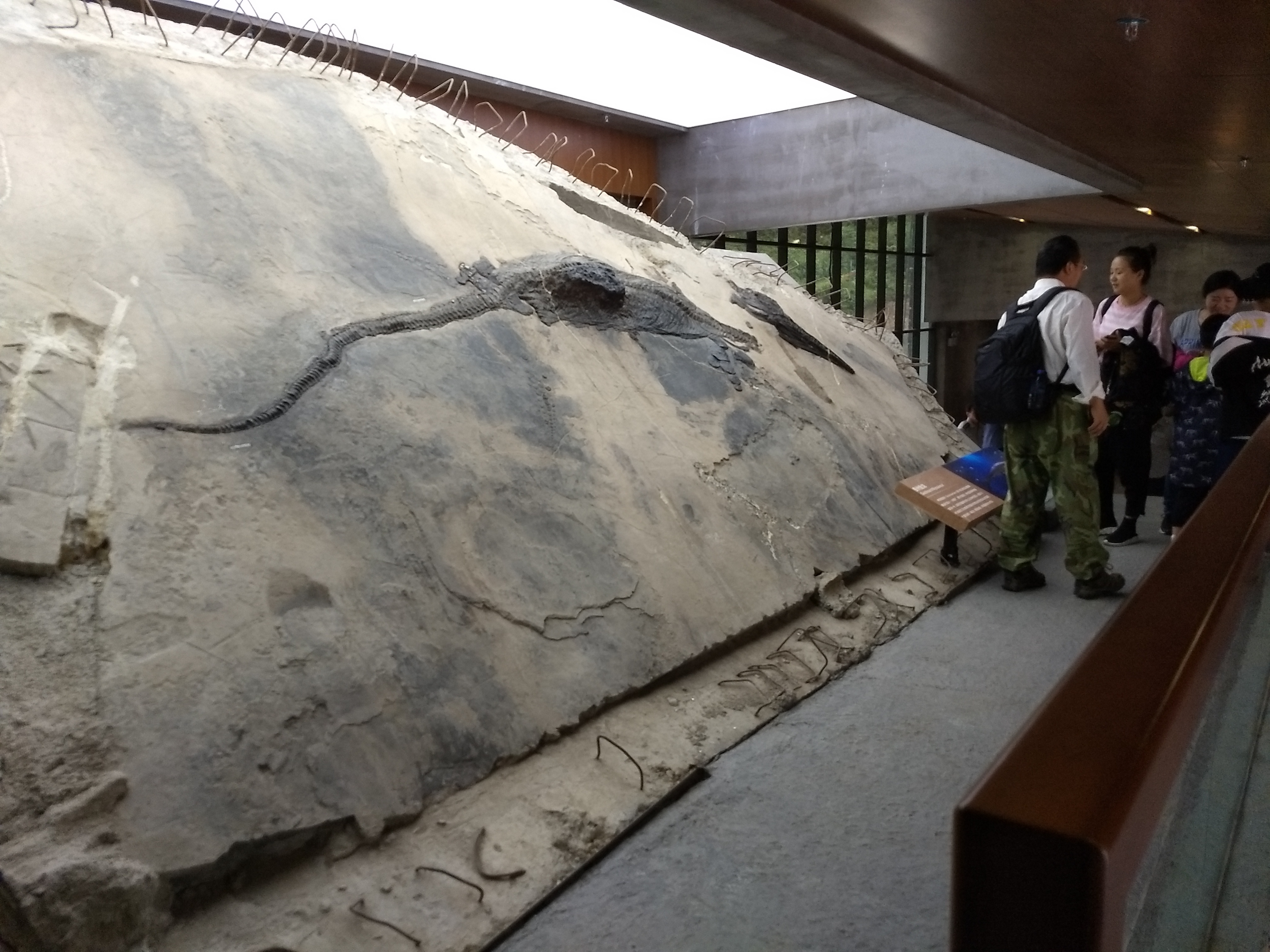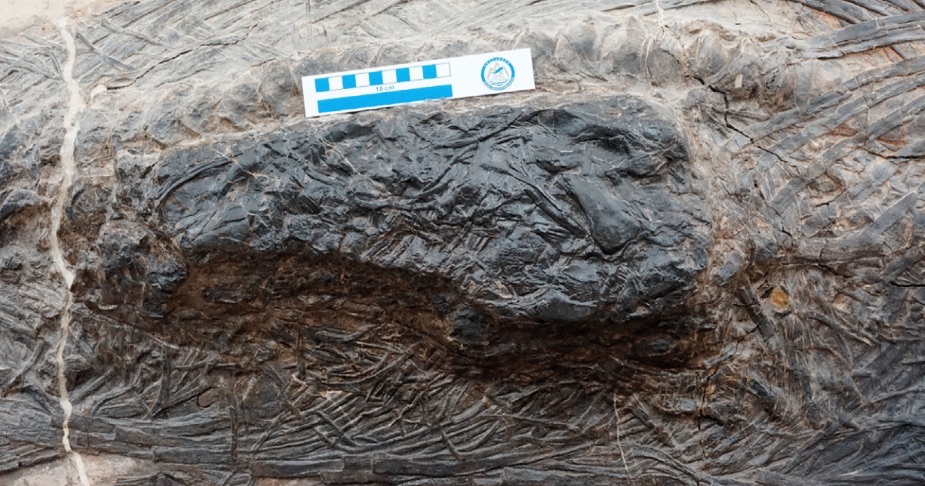Fossilized 'ocean lizard' found inside corpse of ancient sea monster
A Triassic sea monster v. sea monster event.

About 240 million years ago, one giant sea monster ate another, and then died with chunks of the beast in its belly. Researchers in China have now discovered and analyzed the fossilized corpses of these beasts, which they are calling the oldest evidence of megapredation — when one large animal eats another — on record.
It remains a mystery, however, exactly how the larger predator — an ichthyosaur, a dolphin-like marine reptile that lived during the dinosaur age — came to feast on the slightly smaller sea monster, a thalattosaur, a fearsome lizard-like marine reptile that lived during the latter part of the Triassic period.
The ichthyosaur may have attacked and killed the thalattosaur before eating it, but it's also feasible that the ichthyosaur was simply scavenging the thalattosaur's remains, the researchers said.
Related: Image gallery: Ancient monsters of the sea
Whatever happened, the ichthyosaur, likely a new species from the genus Guizhouichthyosaurus, never took another bite. "It is most likely that the thalattosaur was its last meal, given that the prey had poorly been digested when the predator died," study co-lead researcher Ryosuke Motani, a paleobiologist at the University of California, Davis, told Live Science in an email.
Researchers found the remarkable fossil in the fall of 2010, while digging at a quarry in the Falang Formation in the southwestern province of Guizhou, China. "We could see a small piece of the fossil hidden in the hill" and realized that "it must be from a large ichthyosaur," study co-lead researcher Da-yong Jiang, a paleobiologist at Peking University in Beijing, China, told Live Science in an email.
As the researchers prepared the nearly 16-foot-long (4.8 meters) specimen to study, they realized it held the bones of the ichthyosaur's last meal bulging out of its abdomen.
Get the world’s most fascinating discoveries delivered straight to your inbox.
"Finding any animal other than fish or squid in an ichthyosaur's stomach contents is incredibly rare (in fact, finding fish/squid in an ichthyosaur stomach is also quite rare); only a handful of other different types of animal have been found inside an ichthyosaur's stomach, as food," Dean Lomax, a paleontologist and visiting scientist at the University of Manchester in England, who wasn't involved with the study, told Live Science in an email.
"The discovery of a fairly large (4.8 m) ichthyosaur with a comparatively very large (4 m) thalattosaur dinner is highly unusual," Lomax added.






The head and tail of the more slender thalattosaur, identified as Xinpusaurus xingyiensis, were not swallowed by the ichthyosaur, so it appears that the ichthyosaur took four enormous bites of the thalattosaur's midsection, based on the pieces the researchers found in the predator's abdomen.
Related: The 10 weirdest sea monsters of 2017
About 80 feet (25 m) away from the Guizhouichthyosaurus, the researchers found the fossil of a Xinpusaurus tail that might belong to the same Xinpusaurus that ended up in the ichthyosaur's stomach. "If this is correct, then it might suggest that the predator had 'bitten off more than it could chew,' so to speak, in that it was a much larger meal than it had anticipated, and which could have led to its downfall," Lomax said.
Researchers often guess what ancient predators ate by analyzing their tooth shape and body size. Surprisingly, this genus of ichthyosaur, which usually measured between 13 and 20 feet (4 and 6 m) long, or just smaller than a killer whale (Orcinus orca) — was not previously thought to be an apex predator.
"This predator did not have a typical dentition of the top predator — its teeth look like they are good for grasping squids," Motani said. "So, it was a surprise to find such large prey" in its stomach. The finding changes the view of other large reptiles with teeth like Guizhouichthyosaurus's. They "may have also been megapredators, although we did not consider them as such before," Motani said.
In other words, fierce megapredators didn't necessarily need sharp, slicing teeth to be dangerous, Motani noted. Perhaps Guizhouichthyosaurus used its blunt teeth to grip prey, possibly breaking the spine with the force of its strong bite, just as modern apex predators such as orcas, leopard seals and crocodiles do today, the researchers said.
"This study has compelling evidence that we are underestimating the number of megapredator taxa in marine ecosystems," said Eric Metz, the manager of a paleobiology laboratory at Montana State University, who wasn't involved with this study.
Because megapredators rely on a vast food chain beneath them for survival, their prevalence can reveal whether an ecosystem was doing well. For instance, earlier research on the end-Permian mass extinction, which killed more than 96% of marine and 70% of land animals about 252 million years ago, used the presence of megapredator fossils to show when ecosystems had recovered.
If paleontologists have been undercounting megapredators, "This could have an impact on our understanding of the recovery rate of marine ecosystems following the Permian mass extinction event," Metz said.
The study was published online today (Aug. 20) in the journal iScience.
Originally published on Live Science.

Laura is the managing editor at Live Science. She also runs the archaeology section and the Life's Little Mysteries series. Her work has appeared in The New York Times, Scholastic, Popular Science and Spectrum, a site on autism research. She has won multiple awards from the Society of Professional Journalists and the Washington Newspaper Publishers Association for her reporting at a weekly newspaper near Seattle. Laura holds a bachelor's degree in English literature and psychology from Washington University in St. Louis and a master's degree in science writing from NYU.
 Live Science Plus
Live Science Plus





